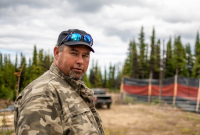Support strong Canadian climate journalism for 2025
We have literally watched as global temperatures climbed to new heights last fall in chart after chart of temperature trends. It’s an easy way for us to grasp just how fast climate change is moving. But it makes me wish we could present an equally clear and simple picture of biodiversity trends.
Looking at biodiversity over the past few years, one trend stands out: the decline and extinction of wild species. Wildlife Conservation Society Canada’s 2023 annual evaluation of edge of extinction species found a 40 per cent increase in the number of species in Canada at imminent risk of disappearing. This increasing number reflects a growing concern for species we already know are at risk and new information about the increased risk faced by additional species.

There are almost 200 edge-of-extinction species found across Canada, with the highest numbers found in B.C., Quebec, Ontario, Alberta, and Nova Scotia. But perhaps more troubling than the number, or locations, is the trend, which, just like global temperature averages, continues to spike.
Our planet is becoming a lonelier, less diverse place because we are losing plants and animals that once lived beside us. Barring some technology that can clone extinct species, no human will ever again witness the great auk, passenger pigeon, Tasmanian tiger or Steller’s sea cow, and hundreds of other wild animals.
But despite this evidence of extinction, the risk of more wildlife disappearing has only accelerated, with estimates that up to one million species could be at risk of extinction in the coming decades.
Preventing extinction is not just a task for tropical countries, and it’s not just about pandas and polar bears.
Every country has a role to play in stopping the loss of all life on Earth. Here in Canada, a country with some of the last big wild places left on the planet, one in five species is at some level of risk. Of all the wild species that need our attention, there is a group that is urgently important for conservation action. Those species that are teetering at the edge of global extinction.

Using data from the International Union for Conservation of Nature and NatureServe, Wildlife Conservation Society Canada has identified 187 species found in Canada at imminent risk of disappearing forever. For species such as the whooping crane and sand-verbena moth we share the conservation responsibility with other nations. Others, such as the Gulf of St. Lawrence aster and Vancouver Island marmot are only found in Canada.
Their survival is entirely up to us.
Canada’s edge-of-extinction species face many threats, including invasive species, habitat loss, and climate change. For some, our actions have not been enough to stop their decline. We haven’t even tried to halt the extinction of others.
It’s too late to save Canada’s Labrador duck or Dawson caribou from extinction. But we can be the generation that holds on tighter to our collective natural wealth. There is reason for hope. Past conservation actions have prevented the extinction of wildlife ranging from pronghorn antelope, to eastern bluebird. But we need to amplify these actions and make wildlife conservation an integral part of our economy and society.
From identifying and conserving Key Biodiversity Areas to businesses investing in nature-positive outcomes, many of the solutions to stop extinction and reverse the decline of wildlife are well known and only require us to act.
We all have a role to play in stopping extinctions.
The wildlife decline can be reversed.
Dan Kraus is the director of national conservation for the Wildlife Conservation Society Canada (WCS Canada). He supports and manages WCS Canada’s portfolio of national initiatives including key biodiversity areas, One Health, biodiversity policy and natural climate solutions.






Comments
Yes, it is utterly tragic, the loss of species and biodiversity more generally. I used to think that when people understood what we were losing, we would take and destroy less, but sadly few seem to care. On the contrary, disregard for the consequences of a transition to so-called "clean/green" energy will be a boon for a growth economy, but will simply compound the ecological crisis in which we find ourselves.